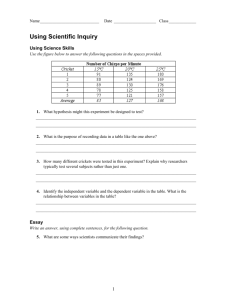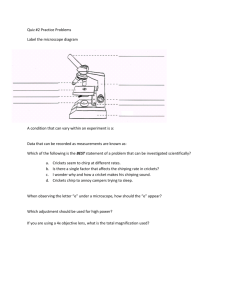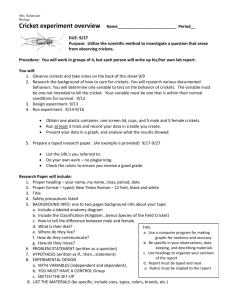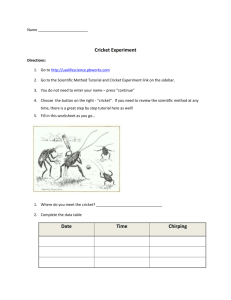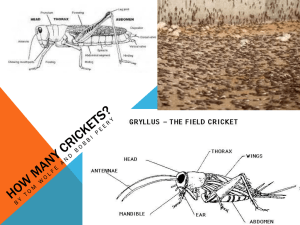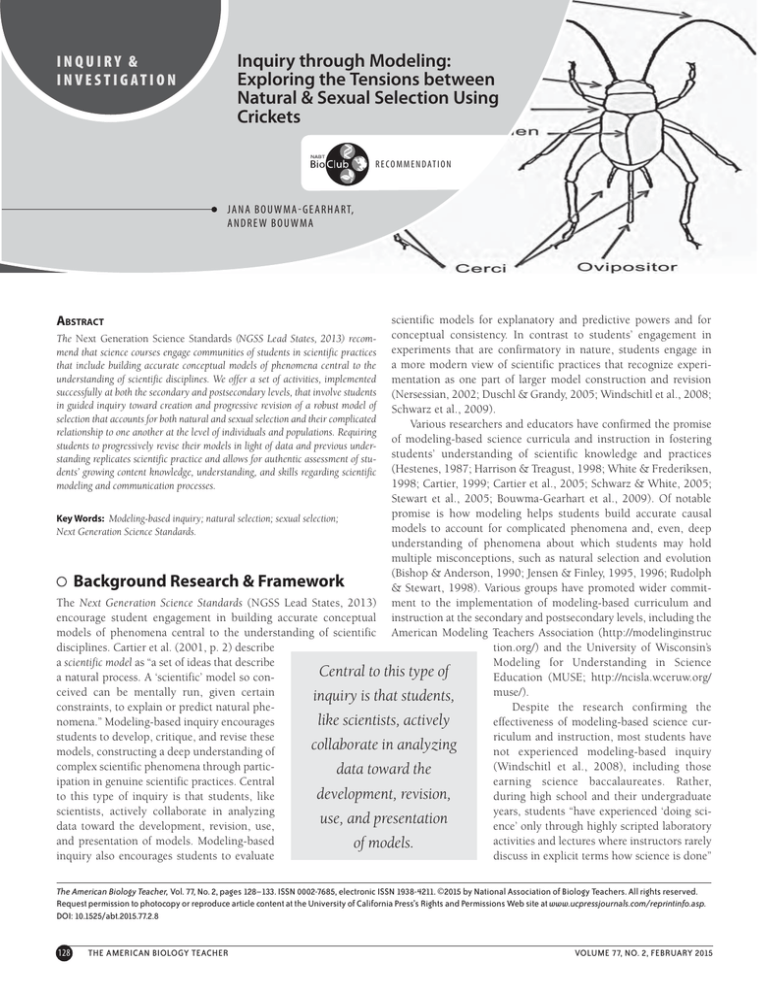
INQUIRY &
I N V E S T I G AT I O N
Inquiry through Modeling:
Exploring the Tensions between
Natural & Sexual Selection Using
Crickets
R E C O M M E N D AT I O N
J A N A B O U W M A - G E A R H A RT,
ANDREW BOUWMA
ABSTRACT
scientific models for explanatory and predictive powers and for
conceptual consistency. In contrast to students’ engagement in
experiments that are confirmatory in nature, students engage in
a more modern view of scientific practices that recognize experimentation as one part of larger model construction and revision
(Nersessian, 2002; Duschl & Grandy, 2005; Windschitl et al., 2008;
Schwarz et al., 2009).
Various researchers and educators have confirmed the promise
of modeling-based science curricula and instruction in fostering
students’ understanding of scientific knowledge and practices
(Hestenes, 1987; Harrison & Treagust, 1998; White & Frederiksen,
1998; Cartier, 1999; Cartier et al., 2005; Schwarz & White, 2005;
Stewart et al., 2005; Bouwma-Gearhart et al., 2009). Of notable
promise is how modeling helps students build accurate causal
Key Words: Modeling-based inquiry; natural selection; sexual selection;
models to account for complicated phenomena and, even, deep
Next Generation Science Standards.
understanding of phenomena about which students may hold
multiple misconceptions, such as natural selection and evolution
(Bishop & Anderson, 1990; Jensen & Finley, 1995, 1996; Rudolph
J Background Research & Framework
& Stewart, 1998). Various groups have promoted wider commitThe Next Generation Science Standards (NGSS Lead States, 2013) ment to the implementation of modeling-based curriculum and
encourage student engagement in building accurate conceptual instruction at the secondary and postsecondary levels, including the
models of phenomena central to the understanding of scientific American Modeling Teachers Association (http://modelinginstruc
tion.org/) and the University of Wisconsin’s
disciplines. Cartier et al. (2001, p. 2) describe
Modeling for Understanding in Science
a scientific model as “a set of ideas that describe
Central to this type of
Education (MUSE; http://ncisla.wceruw.org/
a natural process. A ‘scientific’ model so conmuse/).
ceived can be mentally run, given certain
inquiry is that students,
Despite the research confirming the
constraints, to explain or predict natural phelike scientists, actively
effectiveness of modeling-based science curnomena.” Modeling-based inquiry encourages
riculum and instruction, most students have
students to develop, critique, and revise these
collaborate in analyzing
not experienced modeling-based inquiry
models, constructing a deep understanding of
(Windschitl et al., 2008), including those
complex scientific phenomena through particdata toward the
earning science baccalaureates. Rather,
ipation in genuine scientific practices. Central
development, revision,
during high school and their undergraduate
to this type of inquiry is that students, like
years, students “have experienced ‘doing sciscientists, actively collaborate in analyzing
use, and presentation
ence’ only through highly scripted laboratory
data toward the development, revision, use,
activities and lectures where instructors rarely
and presentation of models. Modeling-based
of models.
discuss in explicit terms how science is done”
inquiry also encourages students to evaluate
The Next Generation Science Standards (NGSS Lead States, 2013) recommend that science courses engage communities of students in scientific practices
that include building accurate conceptual models of phenomena central to the
understanding of scientific disciplines. We offer a set of activities, implemented
successfully at both the secondary and postsecondary levels, that involve students
in guided inquiry toward creation and progressive revision of a robust model of
selection that accounts for both natural and sexual selection and their complicated
relationship to one another at the level of individuals and populations. Requiring
students to progressively revise their models in light of data and previous understanding replicates scientific practice and allows for authentic assessment of students’ growing content knowledge, understanding, and skills regarding scientific
modeling and communication processes.
The American Biology Teacher, Vol. 77, No. 2, pages 128–133. ISSN 0002-7685, electronic ISSN 1938-4211. ©2015 by National Association of Biology Teachers. All rights reserved.
Request permission to photocopy or reproduce article content at the University of California Press’s Rights and Permissions Web site at www.ucpressjournals.com/reprintinfo.asp.
DOI: 10.1525/abt.2015.77.2.8
128
THE AMERICAN BIOLOGY TEACHER
VOLUME 77, NO. 2, FEBRUARY 2015
(Windschitl et al., 2008, p. 311). We advocate for students’ opportunities to develop, critique, and apply models via curriculum
developed by instructor–facilitators with specific learning outcomes
in mind, outcomes for both the models to be constructed and the
specific processes that students will engage in to discover them.
Of utmost importance is that students engage in modeling-based
inquiry to develop deep understanding of phenomena most central
to understanding the discipline – in this case, the phenomena of
evolution.
Toward accurate and deep understanding of evolution as the
core model underlying biology, students must develop accurate
submodels concerning natural and sexual selection, concepts about
which students hold multiple, deep-seated misconceptions (Bishop
& Anderson, 1990; Jensen & Finley, 1995, 1996; Demastes et al.,
1996; Rudolph & Stewart, 1998). In addition, they must explore
how these two submodels interrelate in their contribution to the
larger model of evolution. This paper presents a novel and engaging
set of activities that addresses these needs.
An Activity for Engaging Students in
Modeling-based Inquiry
J Our activity stems from both authors’ involvement in a project as
secondary and postsecondary educators in the creation, implementation, and study of modeling-based inquiry curriculum and instruction. The curriculum described below has been taught and assessed
in two high school biological science classrooms as well as in two
postsecondary courses for biology majors and preservice science
educators.
For those attempting to meet the Next Generation Science
Standards, our activity engages students in the following scientific practices discussed under Dimension 1: developing and using
models; analyzing and interpreting data; constructing explanations;
engaging in argument from evidence; and obtaining, evaluating, and
communicating information.
Specifically, our activities meet standards for grade 12, when
students should be able to discuss the limitations and precision of
a model and suggest ways in which the model might be improved
to better fit available evidence, offer causal explanations, identify
possible weaknesses in scientific arguments, and discuss them using
reasoning and evidence.
Introducing Scientific Models
J We begin our instruction by briefly detailing scientific models and
scientists’ role in constructing and interacting with them. Yet our
students’ firm understanding of models and the processes associated with modeling-based inquiry is mostly developed through the
curriculum as they develop, revise, and argue the worth of them.
Most important to convey to students initially is that the strongest
scientific models (according to Cartier et al., 2001)
UÊ are empirically consistent (account for all data),
UÊ are conceptually consistent (realistic), and
UÊ have predictive power.
Toward this introduction, we provide guidance from the Project
MUSE website at http://ncisla.wceruw.org/muse/models/index.html.
THE AMERICAN BIOLOGY TEACHER
Students Construct a Model of Natural Selection
It is imperative that educators begin these activities by ensuring that
students have a firm basic model of natural selection, namely that if a
particular genetically based trait confers greater survival to reproductive age in a particular environment, relative to individuals that lack
the trait, then this trait will become more common in subsequent
generations. For students with limited understanding of natural
selection, we recommend taking them through a 1-week curriculum
on natural selection created by Project MUSE. For postsecondary,
or other students with more experience in biology, an educator can
review the main premises of the model of natural selection. The ultimate goal of this review of natural selection is to launch students into
the next phases of model development, (1) adding to their already
constructed model to account for sexual selection (traits favored
that increase the ability to obtain a mate) and (2) using/revising
their model to explore the relationship between natural and sexual
selection.
Students Add to Their Model to Account for
Sexual Selection
We use Acheta domesticus, the common house cricket, as a “model”
organism for this modeling-based inquiry, since it can be easily and
inexpensively obtained from any local pet store. A sexually selected
phenomenon that can be easily studied in a lab, or witnessed on
video, is house cricket aggression. Aggression can be stimulated
in adult male house crickets by housing them in isolation in small
plastic “deli” containers (~10 cm diameter) for 1 to 2 days. (Crickets
must be provided with a water source while in captivity, also available
at your local pet store.)
We begin by eliciting students’ thoughts about how one would go
about scientifically recording animal behavior. We then have students
each construct an ethogram (descriptive record of all of an organism’s
behavior) of solitary crickets for about 10–15 minutes (Figure 1).
What students see are mostly grooming, feeding (if they have a
food source), and locomotor behaviors. We charge student groups
to describe what they see and to make decisions regarding behavior
terminology. We provide Figure 2 to help them speak with a common
language about cricket morphology.
Next, we have students observe, for several minutes, 5 previously isolated male crickets together in a 10-gallon aquarium or
other container, assigning each student to construct an ethogram
of their assigned (and paint-pen-marked) cricket. This can also be
observed as a video but is much more exciting for students to witness in person (visit http://youtu.be/TBLrH5OTCuI for a sample of
what they could see). We now ask students, as a class, to describe
what they see and to make decisions regarding behavior terminology; students offer terms like antenna touching, head (mandible)
locking, shaking, chirping, kicking, turning away, and avoidance (for
figures and descriptions of different agonistic behaviors in crickets,
see Alexander, 1961). We then allow students to observe for another
10–15 minutes before comparing data and identifying patterns
within groups, as well as determining a dominance hierarchy among
the crickets. (In agonistic confrontations, we define “dominant”
crickets as those that stand their ground, while subordinates eventually turn away.) We then charge students to “think like evolutionary
biologists” and propose an explanatory model to account for the
observed data. We ask them to explain, “Why would natural selection favor aggression in crickets?”
INQUIRY THROUGH MODELING
129
Cricket Ethogram
Descriptive name
for behavior
Description of behavior
and social context
Number of observations
be exhibited by previously isolated female
crickets as well. It has never failed that multiple students make this inference and request
to observe previously isolated female crickets
interacting. We are happy to oblige.
Students Use/Revise Their Model
of Selection to Account for Both
Natural & Sexual Selection
Figure 1. Partial ethogram template (for five behaviors).
Figure 2. Cricket morphology.
A key thing happens for students at this point in the curriculum.
Many students first hypothesize that the aggression witnessed is
related to cricket survival and fighting to defend against predators or
gain access to food, water, or space resources. At this point, we briefly
review with students what makes for a legitimate scientific model,
namely that it is realistic and empirically consistent with the data at
hand. We ask them if the natural selection–based model that many
offer to explain male cricket aggression meets these criteria (it does).
This is an important juncture for students regarding the other criteria
used to judge a model’s strength, that being its predictive power. We
remind them of this critical scientific model criterion and ask them to
consider how they can test their natural selection–based explanatory
model concerning cricket aggression. For if the natural selection–
based model that many offer to explain the male cricket aggression
is an accurate one, then we can predict that the same aggression will
130
THE AMERICAN BIOLOGY TEACHER
We then allow students about 10–15 minutes,
in class or via video, to observe five previously isolated female crickets together in a
10-gallon aquarium. Once again, each cricket
is marked and assigned to a student, and
students add any new observed behaviors
to ethograms. Again they compare data as a
group and as a class. What they note is that
the female crickets groom, feed, walk, but
mostly ignore one another. We again challenge them to think like evolutionary biologists, having them consider why there is a
difference in behavior between the crickets
by sex and, again, why would natural selection favor male aggression in crickets? Students easily conclude that
enhanced male aggression may allow for better access to a resource
that goes beyond a need for mere survival (water, food, space, predators) and is, instead, meeting a need for something else. Students usually hypothesize at this point that male crickets’ aggression enhances
their reproductive success by allowing access to, or attracting the
preference of, females.
This idea is valid in that it matches the data that students have at
hand. But their data are still limited. At this point, given enough time
and considerations of students’ abilities and knowledge, we often ask
students to consider what data would help to test their explanation.
Often, students collectively propose tests akin to studies done by
Nelson and Nolen (1997) that, in effect, test the actual mating success of male crickets immediately after fighting with other males; we
provide students with the key data (see Figure 3).
Students easily deduce that enhanced male aggression
(measured by “battles won” against other males) increases mating
success by allowing more aggressive males to monopolize access to
females.
At this point, we require that students speak, or write, of their
explanations in terms of their developing larger model of selection.
Their more basic model of selection has been revised to account for
the new data at hand, that being that certain sex-specific behaviors (in this case, greater aggression in male crickets) may allow for
enhanced reproductive capacities. We have achieved an important
milestone of this collective set of activities in terms of students’ modeling and understanding of selection. Students, using data they have
analyzed, sought, and predominantly collected themselves, have
been led to revise their larger model of selection, which originally
consisted only of the underlying premises associated with natural
selection, to a larger model of selection that accounts for sexual selection as well. At this point, we make sure that all of our students have
arrived at the following set of related conclusions concerning their
model: (1) survival to reproductive age (natural selection) is not the
only issue for organisms and (2) there is also the need to reproduce
VOLUME 77, NO. 2, FEBRUARY 2015
Figure 3. Matings of male winners and losers when placed
Figures 4. Number of visits by female crickets per pulses per trill
together in a container with one female (adapted from Nelson
and Nolen, 1997).
of artificial “male” cricket calls (adapted from Gray & Cade, 1999).
(for sexual organisms, this equates to a need for access to mates and
successful copulation).
We now begin to move them toward developing a model that
better accounts for the nuances of the interplay of natural and sexual
selection.
Students Use/Revise Their Model to Explore the
Relationship between Natural & Sexual Selection:
An Opportunity for Authentic Assessment
We again provide students with data they can evaluate toward further
revision of their model to a more scientifically complete and robust
one. The next set of data concerns the Texas field cricket (Gryllus
texensis), an organism with a relatively large amount of diversity in
its song, measured as sound pulses per trill (chirp). We point out
to students that there are two kinds of sexual selection, first identified by Charles Darwin (1871). Intrasexual selection favors traits that
increase success in competition for matings, such as the male–male
aggression in crickets. Intersexual selection favors traits that increase
success in attracting the opposite sex for mating. Male cricket
“advertisement” song is such an intersexually selected trait: it attracts
females for mating. In addition to attracting females with its advertisement song (intersexual selection), the Texas field cricket attracts a
parasitoid fly, Ormia ochracea, that lays its eggs on the male crickets,
eventually killing them (see Figures 4 and 5).
Educators may choose to have students continue working with
others in their model revision. Alternatively, we have used the above
data, and the corresponding questions below, as an individual-level
written assessment to gauge students’ ability to construct and revise
scientific models, their understanding of how to judge the strength of
models, and their ability to communicate about all of this.
Figure 5. Number of visits by female parasitoid flies per pulses
per trill of artificial “male” cricket calls (adapted from Gray &
Cade, 1999).
(2)
(3)
(4)
Assessment Questions
J (1) Gray and Cade observed a large amount of variability in the
number of pulses per trill in song (compared with closely
related species) among males in the population of Gryllus texenis. Assuming that there has been plenty of evolutionary time
THE AMERICAN BIOLOGY TEACHER
(5)
for the trait to evolve to become less variable, use your knowledge of selection (both natural and sexual selection) to construct an explanation for why cricket song has remained so
variable in this population.
Describe any revisions to your model of selection in terms of
the relationship between natural and sexual selection.
Think again like evolutionary biologists and predict what will
happen to the song characteristics in the population over many
generations, with both natural selection (the flies) and sexual
selection (female crickets) present.
Evaluate the “strength” of your model. To what extent does
your model meet the criteria for a strong scientific model?
What role(s) does the greater scientific community play in
evaluating scientific models?
We have again asked students to revise their model toward one
with greater empirical consistency (to again account for all data).
INQUIRY THROUGH MODELING
131
The students easily observe that both the parasitoid and the female
crickets appear to prefer male crickets with the same song characteristics, which means that while sexual selection favors a particular
song type (45 pulses per trill), natural selection makes that song the
riskiest to perform.
Students conclude that the relationship between natural and
sexual selection is sometimes complicated, and that natural and sexual
selection can be “at odds” with one another for particular traits. With
both types of selection working at cross-purposes, students suggest
that this may maintain variation in pulses per trill in the population.
We sometimes challenge them to make predictions about what we
might expect to observe if the parasitoid flies were extirpated from
the population. Students hypothesize that if the natural selection
from the parasitoid flies were to disappear from the population, then
the cricket song profile favored by sexual selection would predominate, and the existing variation in pulses per trill might be lost.
Here, we provide excerpts from secondary students’ work.
Student 1:
The amount of variation in the population is probably
due to their environment. The Gryllus texensis species of
cricket lives in the same environment as the parasitoid fly
– Ormia ochracea. The reason for the wide variation in
number of pulses per trill in the males is probably caused
by the fly who deposits her larva onto the males, which
kills them shortly after. The trait for the number of pulses
is heritable, and there was variation to begin with. There
must be a balancing factor which keeps the number of
pulses per trill from creeping closer to 45.
[…]If the female crickets choose these males and so
do the flies, there is both an advantage (sex. sel.) and a
disadvantage to the having 45 pulses. More male crickets
are born with the trait for 45 pulses but an equal number
die from the wound by the fly. The variation, then, will
remain in the population because the trait is not more
advantageous than 25 or 65 pulses[…].
In other closely related cricket populations, the numbers may be closer to 45/the females may hear this the
best because there are no parasitoid flies in the area.
Student 2:
I imagine that it is relatively rare that a trait is acted upon
by two different selective processes by two relatively similar sources, i.e. natural selection working through the
parasitoid flies, and sexual selection working through
female crickets. I would consider the two selection factors similar especially because they have developed a very
similar organ to sense the trait in male crickets.
[…]Furthermore, the two selection process [sic] work
against each other in that one process (sex. sel.) happens
to select for the trait and the other process (nat. sel.)
selects against the trait. Without parasitoid flies, females’
selection would cause the trait of having 45 pulses per
trill to become more prevalent; but conversely, without
considering the female crickets, the female parasitoid fly
would cause the trait to become less prevalent through the
generations[…].
So in others, with both the number of pulses per trill at
the same time, the variability sort of “balances out” to an
apparent degree. No variation in the trait is so much more
helpful or detrimental, in the end making each male just
as likely to pass on his genes as any other male.
132
THE AMERICAN BIOLOGY TEACHER
Students are overwhelmingly successful, at this point, in arguing
for the strength of their model, one that has empirical and conceptual consistency and predictive power. They recognize that evaluation of a model’s strength is ultimately performed by a larger scientific
community that provides additional assessment per these criteria via
more prediction, relevant empirical tests, and certification of model’s
conceptual consistency with other understandings of nature.
Assessment of Student Gains
J Success in implementing the curriculum with secondary and postsecondary students confirms of modeling-based inquiry as a strong
theoretical construct toward the creation of curriculum and instruction to meet the vast bulk of what the Next Generation Science
Standards and other key policy documents and stakeholders continue to call for. We analyzed two classes each of students’ secondary
(grades 10–12) and postsecondary work, via pre- and post-activity
implementation assessments (surveys and interviews) and students’
class projects and presentations at the end of the course, for content
and process of science knowledge. Our analysis indicated that students gained
UÊ Ecology content knowledge
UÊ Robust understanding of scientific models and the role they
play in science
UÊ Understanding, competence, and overall positive affect with
regard to scientific modeling and associated processes as the
basis of scientific inquiry and community norms
UÊ Empowerment to engage in scientific modeling practices
UÊ Enjoyment regarding MBI-based teaching methods and framework that they deemed unique when compared with other science courses
Students also demonstrated growth in their conceptions of how
science is done. When asked to describe the process of doing science
precourse, students gave typical answers, consisting of a memorized and sequential “scientific method” or a more nebulous “critical
thinking about a problem.” Postcourse, students were more likely to
conceptualize science through modeling and stressed other key components of doing science (like communicating with a larger scientific
community) in relation to modeling.
Additionally, students indicated that their engagement in scientific
processes through the curriculum was novel. Precourse, most students
claimed to have experienced participating in real science before, citing
working through a common laboratory exercise. Postcourse, more recognized that they had not actually participated in the larger process
of science, describing the course’s curriculum as helping them work
through and recognize more complete and nuanced processes. While
constructing robust, scientifically accepted conceptual models central
to scientific disciplines, this modeling-based inquiry curriculum also
fostered students’ understanding of the processes of inquiry, collaboration, and communication regarding crosscutting concepts in science
via participation in communities akin to those of practicing scientists.
Conclusion
J Engagement with authentic scientific practices is woefully absent from
students’ experiences in K–16 classrooms. Modeling-based inquiry is
VOLUME 77, NO. 2, FEBRUARY 2015
a promising framework through which to engage students in these
practices, while ensuring their deeper understanding of concepts
central to a science discipline. While the curriculum described above
was specific to phenomena regarding evolution, modeling-based
inquiry can be, and has been, used effectively to help students learn
about various phenomena. For other examples, see the University
of Wisconsin’s MUSE website (http://ncisla.wceruw.org/muse/index.
html) and Stewart et al. (2005).
References
Alexander, R.D. (1961). Aggressiveness, territoriality, and sexual behavior in
field crickets (Orthoptera: Gryllidae). Behaviour, 17, 130–223.
Bishop, B.A. & Anderson, C.W. (1990). Student conceptions of natural
selection and its role in evolution. Journal of Research in Science
Teaching, 27, 415–427.
Bouwma-Gearhart, J., Stewart, J. & Brown, K. (2009). Misapplication of a gaslike model to explain particle movement in heated solids: implications
for curriculum and instruction towards students’ creation and revision
of accurate explanatory models. International Journal of Science
Education, 31, 1157–1174.
Cartier, J. (1999). Learning genetic inquiry through the use, revision, and
justification of explanatory models. Ph.D. dissertation, University of
Wisconsin, Madison.
Cartier, J., Passmore, C., Stewart, J. & Willauer, P. (2005). Involving students
in realistic scientific practice: Strategies for laying epistemological
groundwork. In R. Nemirovsky, A.S. Rosebery, J. Solomon & B. Warren
(Eds.), Everyday Matters in Science and Mathematics. Mahwah, NJ:
Erlbaum.
Cartier, J., Rudolph, J. & Stewart, J. (2001). The nature and structure of
scientific models. Retrieved from http://www.wcer.wisc.edu/ncisla/.
Darwin, C. (1871). The Descent of Man, and Selection in Relation to Sex.
[Reprint.] Princeton, NJ: Princeton University Press.
Demastes, S., Good, R. & Peebles, P. (1996). Patterns of conceptual change in
evolution. Journal of Research in Science Teaching, 33, 407–431.
Duschl, R. & Grandy, R. (2005). Reconsidering the character and role of
inquiry in school science: Framing the debates. In R. Duschl & R. Grandy
(Eds.), Inquiry Conference on Developing a Consensus Research Agenda
(p. 319). New Brunswick, NJ: Rutgers University.
Gray, D.A. & Cade, W.H. (1999). Sex, death, and genetic variation: natural
and sexual selection on cricket song. Proceedings of the Royal Society of
London Series B, 266, 707–709.
Harrison, A.G. & Treagust, D.F. (1998). Modeling in science lessons: are there
better ways to learn with models? School Science and Mathematics,
98, 420–429.
THE AMERICAN BIOLOGY TEACHER
Hestenes, D. (1987). Toward a modeling theory of physics instruction.
American Journal of Physics, 55, 440–454.
Jensen, M.S. & Finley, F.N. (1995). Teaching evolution using historical arguments
in a conceptual change strategy. Science Education, 79, 147–166.
Jensen, M.S. & Finley, F.N. (1996). Changes in students’ understanding of
evolution resulting from different curricular and instructional strategies.
Journal of Research in Science Teaching, 33, 879–900.
Nelson, C.M. & Nolen, T.G. (1997). Courtship song, male agonistic encounters,
and female mate choice in the house cricket, Acheta domesticus
(Orthoptera: Gryllidae). Journal of Insect Behavior, 10, 557–570.
Nersessian, N. (2002). The cognitive basis of model-based reasoning in
science. In P. Carruthers, S. Stich & M. Siegal (Eds.), The Cognitive Basis of
Science (pp. 17–34). Cambridge, UK: Cambridge University Press.
NGSS Lead States. (2013). Next Generation Science Standards. Washington,
DC: National Academies Press. Available at http://www.nextgenscience.
org/next-generation-science-standards.
Rudolph, J.L. & Stewart, J.H. (1998). Evolution and the nature of science:
On the historical discord and its implications for education. Journal of
Research in Science Teaching, 35, 1069–1089.
Schwarz, C.V., Reiser, B.J., Davis, E.A., Kenyon, L., Acher, A., Fortus, D.,
Shwartz, Y., Hug, B. & Krajcik, J. (2009). Developing a learning progression
for scientific modeling: making scientific modeling accessible and
meaningful for learners. Journal of Research in Science Teaching,
46, 632–654.
Schwarz, C.V. & White, B. (2005). Metamodeling knowledge: developing
students’ understanding of scientific modeling. Cognition and
Instruction, 23, 165–205.
Stewart, J., Cartier, J. & Passmore, C. (2005). Developing understanding
through model-based inquiry. In How Students Learn: History,
Mathematics, and Science in the Classroom. Washington, DC: National
Research Council.
Stewart, J. & Rudolph, J.L. (2001). Considering the nature of scientific
problems when designing science curricula. Science Education,
85, 207–222.
White, B.Y. & Frederiksen, J.R. (1998). Inquiry, modeling, and metacognition:
making science accessible to all students. Cognition and Instruction,
16, 3–118.
Windschitl, M., Thompson, J. & Braaten, M. (2008). How novice science
teachers appropriate epistemic discourses around model-based inquiry
for use in classrooms. Cognition and Instruction, 26, 310–378.
JANA BOUWMA-GEARHART (jana.bouwma-gearhart@oregonstate.edu) is an
Associate Professor in the College of Education at Oregon State University,
304k Furman Hall, Corvallis, OR 97331. ANDREW BOUWMA (andrew.
bouwma@oregonstate.edu) is an instructor in the Department of Integrative
Biology at Oregon State University, 3029 Cordley Hall, Corvallis, OR 97331.
INQUIRY THROUGH MODELING
133

